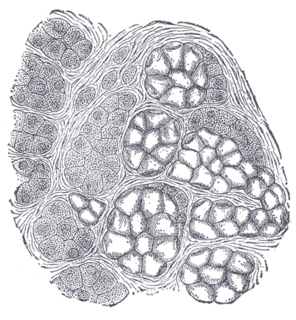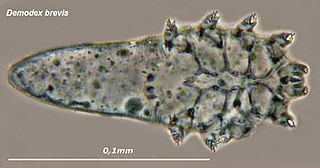
A gland is a group of cells in an animal's body that synthesizes substances for release into the bloodstream or into cavities inside the body or its outer surface.

A sebaceous gland is a microscopic exocrine gland in the skin that opens into a hair follicle to secrete an oily or waxy matter, called sebum, which lubricates the hair and skin of mammals. In humans, sebaceous glands occur in the greatest number on the face and scalp, but also on all parts of the skin except the palms of the hands and soles of the feet. In the eyelids, meibomian glands, also called tarsal glands, are a type of sebaceous gland that secrete a special type of sebum into tears. Surrounding the female nipple, areolar glands are specialized sebaceous glands for lubricating the nipple. Fordyce spots are benign, visible, sebaceous glands found usually on the lips, gums and inner cheeks, and genitals.

Blepharitis is one of the most common ocular conditions characterized by inflammation, scaling, reddening, and crusting of the eyelid. This condition may also cause burning, itching, or a grainy sensation when introducing foreign objects or substances to the eye. Although blepharitis is not sight-threatening, it can lead to permanent alterations of the eyelid margin. The overall etiology is a result of bacteria and inflammation from congested meibomian oil glands at the base of each eyelash. Other conditions may give rise to blepharitis, whether they be infectious or noninfectious, including, but not limited to, bacterial infections or allergies.
An eyelid is a thin fold of skin that covers and protects an eye. The levator palpebrae superioris muscle retracts the eyelid, exposing the cornea to the outside, giving vision. This can be either voluntarily or involuntarily. The human eyelid features a row of eyelashes along the eyelid margin, which serve to heighten the protection of the eye from dust and foreign debris, as well as from perspiration. "Palpebral" means relating to the eyelids. Its key function is to regularly spread the tears and other secretions on the eye surface to keep it moist, since the cornea must be continuously moist. They keep the eyes from drying out when asleep. Moreover, the blink reflex protects the eye from foreign bodies.

Chalazion is a cyst in the eyelid usually due to a blocked meibomian gland. They are typically in the middle of the eyelid, red, and not painful. They tend to come on gradually over a few weeks.

Demodex is a genus of tiny mites that live in or near hair follicles of mammals. Around 65 species of Demodex are known. Two species live on humans: Demodex folliculorum and Demodex brevis, both frequently referred to as eyelash mites, alternatively face mites or skin mites. Different species of animals host different species of Demodex. Demodex canis lives on the domestic dog. The presence of Demodex on mammals is common and usually does not cause any symptoms, although occasionally some skin diseases can be caused by the mites. Demodex is derived from Greek δημός dēmos "fat" and δήξ dēx, "woodworm".

Meibomian glands are holocrine type exocrine glands, along the rims of the eyelid inside the tarsal plate. They produce meibum, an oily substance that prevents evaporation of the eye's tear film. Meibum prevents tears from spilling onto the cheek, traps them between the oiled edge and the eyeball, and makes the closed lids airtight. There are about 25 such glands on the upper eyelid, and 20 on the lower eyelid.

The yellow-necked mouse, also called yellow-necked field mouse, yellow-necked wood mouse, and South China field mouse, is closely related to the wood mouse, with which it was long confused. It was only recognised as a separate species in 1894. It differs in its band of yellow fur around the neck and in having slightly larger ears and usually being slightly larger overall. Around 100 mm in length, it can climb trees and sometimes overwinters in houses. It is found mostly in mountainous areas of southern Europe, but extends north into parts of Scandinavia and Britain. It facilitates the spread of tick-borne encephalitis to humans and is a reservoir species for the Dobrava virus, a hantavirus that is responsible for causing haemorrhagic fever with renal syndrome.

Apodemus is a genus of Muridae. The name is unrelated to that of the Mus genus, instead being derived from the Greek ἀπό-δημος.

Demodex folliculorum is a microscopic mite that can only survive on the skin of humans. Most people have D. folliculorum on their skin. Usually, the mites do not cause any harm, and are therefore considered an example of commensalism rather than parasitism. If D. folliculorum does cause disease, this is known as demodicosis.

The striped field mouse is a rodent in the family Muridae. The range of this species stretches from Eastern Europe to Eastern Asia.
The Jeju striped field mouse is a field mouse found only on Jejudo, an island in the northern East China Sea off the southwestern coast of South Korea. It was originally described in 1965 as a subspecies of Apodemus agrarius. However, a 1992 study of mitochondrial DNA found that it was in fact a separate species.
Moll's gland, also known as the gland of Moll or ciliary gland, is a modified apocrine sweat gland that is found on the margin of the eyelid. They are next to the base of the eyelashes, and anterior to the meibomian glands within the distal eyelid margin. These glands are relatively large and tubular-shaped. The glands of Moll are named after Dutch oculist Jacob Anton Moll (1832–1914).

Demodex brevis is one of the two species of face mite that inhabit humans. They are very similar to Demodex folliculorum, with just a few differences. They are usually found in the sebaceous glands of the human body. The same way that D. folliculorum reproduces in the follicles, D. brevis reproduces in the sebaceous glands. Under normal conditions they are not harmful, and are considered to be commensals rather than parasites or symbionts. During a severe infestation, though, there may be adverse effects on the host, such as demodicosis.
Demodecidae is a family of parasitic mites, living on various species of mammals. Each species of mite is usually only found on a single mammal species, whereas a mammal species can have several different species of demodecid mites living on it. Many species of mites are restricted to very limited areas of their body, e.g. the Meibomian glands, the ear canal, the tongue etc. This family was formerly named Demodicidae.
Amur virus (AMRV) is a zoonotic negative-sense single-stranded RNA virus. It may be a member of the genus Orthohantavirus, but it has not be definitively classified as a species and may only be a strain. It has been identified as a causative agent of hemorrhagic fever with renal syndrome.
Myobia is a genus of mites that live in the fur of rodents, and contains the following species:
TearScience is an American company founded in 2005 that develops, manufactures and markets ophthalmic medical devices aiding in the identification and treatment of Meibomian gland Dysfunction, also known as Dry eye disease, which is a condition that affect as many as 25 million Americans. The company’s Lipiflow System was FDA cleared in June 2011 for treating meibomian gland dysfunction and is currently installed in over 250 locations across the globe. The company is headquartered in Morrisville, North Carolina.

Rhagamys is an extinct genus of rodents in the subfamily Murinae, the Old World mice and rats. The genus was established by the Swiss zoologist Charles Immanuel Forsyth Major to accommodate Rhagamys orthodon, commonly known as Hensel's field mouse or the Tyrrhenian field rat, which is the only species in the genus. It was endemic to the Mediterranean islands of Corsica and Sardinia, where it first appeared in the fossil record in the Late Pleistocene, and was relatively large in size, weighing up to 50 g.










